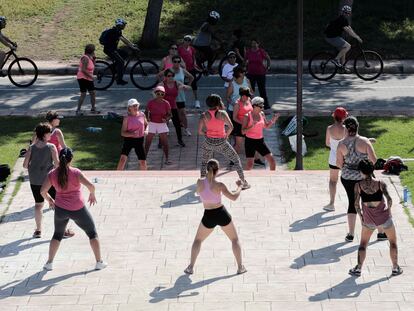Dancing is an effective way for obese people to lose weight
A scientific review has found that creative dance significantly improves body morphology, reducing fat and narrowing waistlines

A scientific review published on Wednesday in the journal Plos One has found that dancing is an effective way for overweight and obese people to lose weight. It has also been shown to significantly improve body morphology, mainly reducing fat mass and waist circumference.
“Regular aerobic exercise performed every week can effectively facilitate weight loss, while concurrently enhancing cardiopulmonary fitness,” states the study be researchers at Hunan University in China. The key to dancing’s effectiveness, compared to other activities, is the ability to enjoy having fun while exercising. “Initiating physical activity is not the primary challenge; the crux lies in sustaining long-term exercise habits. Participants who derive enjoyment from physical activity are more likely to maintain, which indicates the pivotal role of enjoyment as a key factor in sustaining physical exercise.”
The team at Hunan University focused their research on a specific demographic group: overweight or obese individuals, characterized by having a body mass index (BMI) greater than 24 — a normal BMI is between 18.5 and 24.9, although this is questioned by some health professionals — a body fat percentage that exceeds 20% for men and 25% for women. For the study, the researchers only analyzed 10 studies involving dance, with participants practicing at least four time a week. In addition, the researchers followed a control group who continued their normal lifestyle or performed regular physical activity without strict restrictions.
The research primarily focused on fat loss, taking into account a range of metrics including body mass, waist circumference, body fat percentage, fat mass in kilograms, and waist-to-hip ratio. “From the meta-analysis, dance demonstrated the capacity to effectively reduce” all of these parameters, the researchers conclude. However, the study recognizes that no significant differences were found in the waist-hip ratio. “This could potentially be attributed to the comprehensive fat reduction effects induced by dance, which is distributed throughout the entire body rather than being concentrated in a specific anatomical region,” it explains.
When analyzing the different subgroups of dance, researchers found that creative dance, such as Zumba, produces a greater improvement in body composition compared to traditional dance, where there is less notable improvement, probably due to its low intensity.
Antonio Pérez, clinical head of the Endocrinology Service at Sant Pau Hospital in Spain, argues that any amount of exercise, no matter how small, is beneficial to health. He says it’s important to be consistent, regardless of the exercise plan, as the effectiveness of exercise falls if it is not maintained over time. “Dance, in particular, has the added benefit that, if you like it, you end up training more frequently, and it also contributes positively to mental health,” he says.
Regarding the age of the participants, the authors conclude that dance is particularly suitable for younger individuals — under 45 years of age — as an alternative to traditional exercise in terms of fat loss. “Young people are likely to have an advantage due to their ability to achieve and maintain proper training intensity, which is crucial for fat burning,” argues Pérez. However, he warns that these observations are preliminary and should be taken with caution, considering that a comprehensive evaluation of more activities is still pending.
While pointing out the limitations of the research — it only analyzed 10 studies with 646 participants — Dr. Cristóbal Morales, an endocrinologist at the Virgen de la Macarena Hospital in Seville, Spain, says the results are “promising.” He explains that they are in line with what the scientific community has identified about metabolic health. “When physical exercise is fun and sustainable, the results are noticeable in the health of patients,” he says.
Creating a healthy habit
Morales also highlights the fact that the scientific review does not focus solely on weight loss, but also takes into account other factors such as fat mass and hip circumference. “We have been fighting for years in our practice against the idea that only the weight of patients should determine their health status. In endocrinology today, we reject the existence of a single normative size. What we seek is to encourage the creation and maintenance of long-term healthy lifestyle habits,” he adds. “Obesity is a chronic and complex disease that affects half of the adult population; it cannot be reduced to a simple number.”
“One of the biggest problems we have when exercising is what is called adherence, which is the ability to create a habit,” explains César Bustos, a member of the Spanish Obesity Society (SEEDO) and expert in physical exercise. “However, an activity like dancing creates adherence more easily and quickly. It is fun, it is practiced in a group and, as it is low intensity, you do not need to be in good physical shape to start,” he explains.
Even so, Bustos says that, precisely because it is a low-impact activity, in the long term, it should be complemented with a more intense exercise routine. “It’s very suitable at the beginning, to allow people with obesity to start moving without running the risk of injury. Also, it’s an inclusive activity, as you don’t feel judged,” insists Bustos. “But once you have incorporated the habit into your routine, it is essential to maintain a good diet and increase the level of training. Otherwise, you’re likely to quickly regain the lost weight.”
Sign up for our weekly newsletter to get more English-language news coverage from EL PAÍS USA Edition
Tu suscripción se está usando en otro dispositivo
¿Quieres añadir otro usuario a tu suscripción?
Si continúas leyendo en este dispositivo, no se podrá leer en el otro.
FlechaTu suscripción se está usando en otro dispositivo y solo puedes acceder a EL PAÍS desde un dispositivo a la vez.
Si quieres compartir tu cuenta, cambia tu suscripción a la modalidad Premium, así podrás añadir otro usuario. Cada uno accederá con su propia cuenta de email, lo que os permitirá personalizar vuestra experiencia en EL PAÍS.
¿Tienes una suscripción de empresa? Accede aquí para contratar más cuentas.
En el caso de no saber quién está usando tu cuenta, te recomendamos cambiar tu contraseña aquí.
Si decides continuar compartiendo tu cuenta, este mensaje se mostrará en tu dispositivo y en el de la otra persona que está usando tu cuenta de forma indefinida, afectando a tu experiencia de lectura. Puedes consultar aquí los términos y condiciones de la suscripción digital.
More information
Archived In
Últimas noticias
Most viewed
- Reinhard Genzel, Nobel laureate in physics: ‘One-minute videos will never give you the truth’
- Oona Chaplin: ‘I told James Cameron that I was living in a treehouse and starting a permaculture project with a friend’
- Pablo Escobar’s hippos: A serious environmental problem, 40 years on
- Why we lost the habit of sleeping in two segments and how that changed our sense of time
- Chevy Chase, the beloved comedian who was a monster off camera: ‘Not everyone hated him, just the people who’ve worked with him’











































